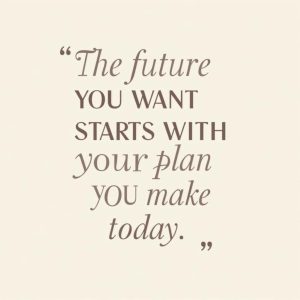Why a life vision is the foundation of everything
Have you ever had a moment where you wondered, “Where am I going with all of this?” It’s a common feeling, especially when life feels like it’s just happening to you, instead of because of you. That’s where a clear life vision comes in.
Having a life vision is more than just dreaming big. It’s about creating a clear, emotionally charged picture of what you want your life to become. It’s the roadmap for your goals, the compass when you’re unsure, and the fuel when your motivation runs low. Without it, many people drift, jump from one thing to another, and burn out quickly, often failing to reach meaningful goals.
You can read more about that in our full guide: Most People Fail at Goals, Here’s Why.
Creating a life vision doesn’t need to be overwhelming. In fact, it can be one of the most exciting and empowering things you ever do. It helps you reclaim control and start living with purpose instead of just reacting to whatever comes your way.
One of the simplest ways to begin? Grab a journal. The act of writing can unlock parts of your mind that thinking alone can’t touch. If you’re looking for a great place to start, we really recommend the Life Compass Journal by BestSelf Co. It’s a guided journal that helps you get clear on your long-term goals, uncover what truly matters to you, and create a vision that actually feels aligned with who you are. It’s structured, motivating, and ideal whether you’re just starting or trying to reset your path.
How to create a clear, motivating life vision
Step-by-step guide to visualizing your future
Alright, let’s not overthink this, just start somewhere. Building a life vision sounds like this huge thing, but honestly, it’s more like tuning into what already pulls at you when no one’s watching.

First off? Your values.
Like, what do you actually care about deep down? Not the stuff that sounds good, the stuff that feels right. Maybe it’s family. Or freedom. Maybe you just want space to create without pressure. Jot down a few. No one’s grading this.
Then close your eyes, yeah, really.
Picture yourself ten years down the line. Everything clicked. You’re not rich just for the sake of it, you’re just… good. What’s your day look like? Who’s around? Where do you wake up? Don’t try to impress anyone with the answers, this one’s just for you.
Now try putting it into words.
Like a mission statement, but chill. Something that reminds you what you’re about when life starts throwing noise your way. It can be a sentence, or a scrappy little paragraph. Doesn’t have to sound like it came from a TED Talk.
Last part, make it real, somehow.
You could slap some images on a board, write in a notebook, whisper it into a voice note, whatever helps you see it. I like journaling, personally. Tools like the Life Compass thing are cool, but a blank page and a pen work too.
Just remember: you’re not marrying this vision. It can shift. You can outgrow it. What matters is that you’re not floating aimlessly. This is about giving yourself a bit of a map, not a prison. Dreams feel a whole lot less scary when you give them structure.
Break it down, 1-year and 5-year planning
So now that your life vision is crystal clear, the next step is to make it actionable. And the most effective way to do that is by breaking it down into manageable timeframes: your 1-year and 5-year plans. Think of these plans as stepping stones leading directly to the vision you just created.

Without this breakdown, even the most inspiring vision can become paralyzing. Big dreams are great, but they need a roadmap.
Why you need both short- and mid-term timelines
Here’s the thing: your 5-year plan gives you long-term direction, while your 1-year plan gives you momentum and focus. Without both, you’re either drifting aimlessly or working blindly. Together, they create a balance between dreaming and doing.
Let’s take an example. Imagine your vision includes running your own creative business, traveling part-time, and living debt-free. That’s a great 10-year destination. But how do you get there?
-
5-Year Plan might include:
-
Learning a high-income creative skill (Year 1–2)
-
Building a freelance business and client base (Year 2–3)
-
Saving and investing with purpose (Year 3–4)
-
Launching your own brand or product line (Year 5)
-
-
1-Year Plan might include:
-
Taking one skill-building course
-
Creating your first portfolio
-
Getting your first paying client
-
Starting a monthly savings habit
-
Launching a simple website
-
The beauty is that your 1-year plan becomes your launchpad, and seeing measurable progress in 12 months builds unstoppable confidence.
Tools to bring your plans to life
You could write your plans on paper, of course. But there are tools that can supercharge your planning process, especially when you’re a visual thinker.
One of our favorite tools is Lucidchart. It lets you create visual timelines, flowcharts, mind maps, and strategic plans. It’s drag-and-drop simple and incredibly powerful for mapping out complex ideas like:
-
1-year quarterly goal timelines
-
5-year progress roadmaps
-
Life balance wheels
-
Value alignment matrices
Honestly, if planners just stress you out or feel like too much, Lucidchart might actually be a breath of fresh air. It’s all drag, drop, move stuff around, it just makes sense visually. And the cool part? You can loop in your coach, a buddy, or whoever’s walking that growth path with you.
Something that worked for me: I laid out my big 5-year dream on a line, like, just stretched it out. Then I zoomed in and figured out what the next few months need to look like. Suddenly, the everyday stuff wasn’t just noise, it was part of the plan.
Keep your planning agile, not rigid
You know, having a plan helps, no doubt. But life doesn’t just sit still and wait for your timeline to work out. That’s why your “1-year plan” or “5-year plan”? It shouldn’t be carved in stone. More like a sketch. Something you come back to every few months, see what’s clicking, what’s off.
Your big dream might still be the same, but the route? Oh, that’ll shift. And honestly, that’s totally normal.
Most of us mess up goal-setting because we think it’s a one-and-done thing. Like, write it down and boom! done. But real planning? It’s more like a rhythm you keep checking in with, not a single checklist you tick once. (Been there, messed that up.) If you’re curious, I actually wrote more on why most people trip up with goals, and how not to fall into that same trap.
Avoid the pitfalls, and plan with purpose
Let’s be honest: planning sounds inspiring, but staying consistent with it? That’s where most people slip. The good news is you can avoid the biggest pitfalls once you know what they are.

5 common mistakes to avoid
- You know that feeling when you set goals just because they sound right? Yeah, that never lasts. If your vision doesn’t hit you in the gut, if it doesn’t light you up a little, you’re probably gonna drop it the moment life throws a curveball. Forget the “shoulds.” Go after what actually stirs something in you.
- Honestly, waiting until everything feels perfectly mapped out is just another sneaky way to avoid starting. I’ve done it. Still do sometimes. But truth is, clarity comes from doing, not from overthinking. Start messy. Fix things later. It’s fine.
- I’ve written out entire plans before and… never looked at them again. Sound familiar? A vision is not a one-and-done thing. Check in with it. Rework it. Every few months, just pause and ask: “Is this still it?” If not, tweak it. Recharge. Keep it alive.
- When your dreams only live in your head, they disappear fast, like smoke. I’ve found that scribbling them somewhere I see every day, on a wall, a notebook, even a sticky note, changes everything. It’s like giving your brain constant little nudges.
- Not every tool is for everyone, period. I tried to be a bullet journal person. I failed. Then I tried to go all-digital… also a mess. What works is what sticks. So if it feels natural, run with it. And if it doesn’t? Don’t force it. Find your groove and trust it.
Tools that help you plan like a pro
Let’s revisit the two tools that can turn your goals from fuzzy ideas into concrete progress:
BestSelf Co. Life Compass Journal
This isn’t just some notebook you toss in a drawer. It kinda becomes a little sidekick for figuring life out. You scribble, you think, you start seeing what actually matters to you. And if you’re the type who needs to write things down to clear the mental fog! yeah, it’s made for that. Week after week, it’s like, “Hey, look how far you’ve come.”
Lucidchart
For the visual thinkers, this is a game-changer. Whether you want to design a flowchart for your career plan, map a financial goal, or organize your weekly priorities in one visual space, Lucidchart delivers. Both tools complement each other beautifully, journal your ideas and emotions, then visualize the structure and timeline.
If you need inspiration? Check out our Guide: Can BestSelf Co. Life Compass Journal Change You To The Best.
it’s your turn now
You don’t need to have it all figured out right now. The most important thing is that you begin. Start small. Dream honestly. Build with structure.
Your life vision isn’t a fantasy, it’s a destination. And your 1-year and 5-year plans are the roads that will get you there.
Whether you’re launching a new business, changing careers, building deeper relationships, or just seeking clarity, your goals deserve more than vague intentions. They deserve a clear, personalized, and powerful plan.
Want to avoid the mistakes most people make? Don’t miss this foundational guide: Why Most People Fail at Goals
And remember:
-
Write it down (Life Compass Journal)
-
Visualize it (Lucidchart)
-
Review it often
-
And take the next small step every day
The life you envision is waiting, go plan for it, and then go live it.



